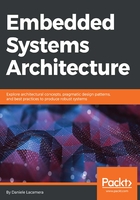
USB
The USB protocol, originally designed to replace UART and include many protocols in the same hardware connector, is very popular in personal computers, portable devices, and a huge number of peripherals.
This protocol works in host-device mode, with one side of communication, the device, exposing services that can be used by the controller, on the host side. USB transceivers present in many microcontrollers can work in both modes. By implementing the upper layer of the USB standards, different types of devices can be emulated by the microcontroller, such as serial ports, storage devices, and point-to-point Ethernet interfaces, creating microcontroller-based USB devices that can be connected to a host system.
If the transceiver supports host mode, the embedded system can act as a USB host and devices can be connected to it. In this case, the system should implement device drivers and applications to access the functionality provided by the device.
When both modes are implemented on the same USB controller, the transceiver works in on-the-go (OTG) mode, and the selection and configuration of the desired mode can be done at runtime.